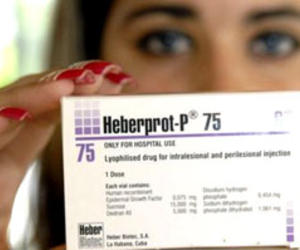Major Award for Heberprot-P
- Submitted by: manso
- Society
- 06 / 05 / 2011

ORTELIO GONZÁLEZ AND RIGO TRIANA. It is no longer news that the Cuban injectable drug Heberprot-P has revolutionized the treatment of patients with diabetic foot ulcers.
It is known that their use reduces the number of amputations of lower limbs, accelerates the healing of damaged tissue, reduces hospital costs and enables faster reintegration into society.
However, despite many advantages, its application has not reached the expected dimensions.
PREPARING FOR THE CHANGE
It's amazing how in less than five years, Heberprot-P has gained a string of hits backed by numerous awards. Last year it was awarded the Special Prize of the International Fair of Havana for the most dynamic new product business, and last March it received the Gold Medal of the World Intellectual Property Organization (WIPO), an institution that in April also conferred it the award for Best Young Inventor.
But the glories do not fill its creators with vanity, who show dissent by considering the therapies have a potential for further expansion, both in Cuba and abroad.
For that reason, Drs. Jorge Berlanga Acosta and Ernesto López Mola, from the Center for Genetic Engineering and Biotechnology, gave lectures in several provinces to spread knowledge about the new product and thereby increase its applications.
During their stay in the Dr. Antonio Luaces Iraola Provincial Hospital, Ciego de Avila, both experts agreed that the country still is not meeting half the potential of patients with such conditions.
To that end it is necessary to strengthen the preparation of angiologists, endocrine, nurses and podiatrists, so that they can resolve the majority of cases, some through prevention in the areas of health, those with less complications in the polyclinics, and those with higher risks in hospitals.
Dr. López Mola said that the emergence of Heberprot-P, unique of its kind globally, changes the paradigms in the management of diabetic foot ulcers.
He added that during the four years since commencing this work, the treatment has reached more than 5,300 patients in the nation, according to the statistics on the cure, but it is estimated that Cuba should include more than 200 patients per week and the actual number does not exceed 50.
According to this data, in Ciego de Avila is there any evidence of care to 240 people suffering from diabetic foot ulcers, of which much is not concentrated in the provincial capital.
Morón is an example of progress in these treatments, according to the criterion of Dr.Jorge Luis Morales Florat, angiologist at the local Roberto Rodriguez Fernandez hospital, who said that studies in the center show similar results to those achieved in the Doctor Antonio Luaces Iraola hospitals, in Ciego de Avila, and the Hermanos Ameijeiras in Havana.
Experts say that the Cuban invention fills a gap in the treatment of these cases, but the greatest prize, which is above all, is the patient cured. Growing up with these kind of laurels, the truly gratifying, but the efforts of specialists and health institutions must be concentrated.
Source: Granma
Comments